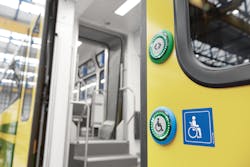Developing Effective Human Machine Interface Systems For Modern Rail Applications
The days of simultaneous door operation systems on passenger rail systems are fading away. Human Machine Interface (HMI) control systems have evolved into the most common area for passenger interaction, therefore requiring them to be reliable, intuitive, and easy-to-use. A majority of new light rail systems in North America, such as the upcoming WMATA 8000 series of the Washington D.C. metro, are cognizant of such changes.
As part of this shift, there has been an increased emphasis on passenger-actuated doors like the ones used in Europe and other foreign markets. While the primary benefit of these new interfaces is improved passenger convenience, additional advantages extend beyond the obvious. Door-opening pushbuttons can increase the lifespan of doors by lowering their overall number of operations and also help meet environmental initiatives by minimizing the loss of heating and cooling that occurs when doors are automatically opened at all stops.
This new development in passenger-access systems requires HMI that reduces the risk of human error by being intuitive, durable, easily visible and providing clear feedback. Unlike the past, HMI is now considered a critical element of the design process and an effective system gives proper consideration to the unique technical, ergonomic and communication requirements of its application.
Capitalizing on experience implementing this technology across the globe, EAO offers helpful tips for developing effective HMI Systems in modern North American rail applications.
General Functionality
How many functions will be controlled by this device? How complex or simple will input be? What feedback will help the passenger easily perform these functions?
As the primary interface between the transit entity and rail public, successful controls combine aesthetically pleasing designs with simple, intuitive functions that help decrease the chance of passenger error.
Defining the Operator
In rail, great HMI design begins with understanding the needs of the user. Commands and functions should be simple and reside within an easy-to-comprehend interface. Pertinent information should be grouped together and intuitive in its placement and operation.
Operator Feedback
Feedback is critical to operator effectiveness and efficiency. In some cases, feedback provides confirmation of an action, while in others it adds to the functionality. This can be visual, auditory, tactile or any combination necessary to provide clear, “mistake-proof” operation.
Secret-Until-Lit legends offer intuitive recognition
Regulatory Standards
A thorough knowledge of technical, ergonomic, design and manufacturing standards is fundamental to HMI system design and proper component selection.
For example, EAO’s Series 57 Door-Opening pushbuttons were designed to meet American Disability Association (ADA) regulations that require controls to be accessible by passengers with disabilities, with simple functionality and ease-of-use. Passenger applications often use audible feedback, such as voice and sound indicators. Audible alerts are also sometimes used to help visually impaired passengers located door actuation pushbuttons or a doorway opening. Some HMI controls can even include override systems and emergency-call equipment prompted by audible, visual and hidden indicators.
In Europe, TSI-PRM sets guidelines for everything from audible levels of alarms to the controls that allow bathroom access.
Large actuation areas, dual illuminating rings, and raised symbols help increase ease of operation
Environmental Considerations
To address potential environmental concerns, stainless steel and durable polymer-based products provide reliable operation under the demanding conditions of rail applications. This includes protection up to IP67, as well as resistance to heat, shock, and vibration. Ideal rail systems are designed for minimal maintenance and long-term use and abuse. A long life-cycle combined with low cost of operation is ideal for transportation companies.
Furthermore, pushbutton door operation helps better regulate the environment within the train. By not opening all doors at every stop, less energy is required to maintain internal temperatures.
Connecting and Communicating with an HMI System
HMI systems in rail applications are typically hard-wired. This ensures no special tools are required and they are simple, visible and easy to understand – especially where the interface controls a single operation such as power distribution.
HMI Component Selection
Once you have defined functionality, you are ready to investigate control technologies. Each technology provides distinct advantages.
Common HMI Components that satisfy the needs of passenger use applications include:
• LED illuminated pushbuttons, switches and indicators
• Keylocks, levers and rotary switches
• Emergency passenger alert functions
• “Secret-Until-Lit” controls
• Simple and complex audible tones
Final Thoughts
To develop an effective and aesthetically pleasing HMI System for rail applications you must focus on optimizing usability, efficiency and safety. Effective HMIs seamlessly integrate with existing controls systems in areas accessible by all passengers. It’s important to possess a thorough understanding of the application, environment and user. Working with an experienced HMI supplier, such as EAO, can help ensure a system meets all standards and provides successful and safe operation.
